The Sales & Marketing Alignment Playbook: How to Fix Misalignment and Drive More Revenue

What's inside









Imagine two teams rowing a boat.
They both want to reach the other side of the lake, but one team is rowing east while the other rows southeast, and they both have different ideas of what the destination is.
They're both working hard, but they won't get where they need to go efficiently, and they might even end up going in circles.
That's what misaligned sales and marketing teams look like—lots of effort, but little forward progress.
When these teams work together, deals close faster, pipeline grows, and marketing efforts translate directly into sales success. But when alignment breaks down, things fall apart.
So what does good sales and marketing alignment look like? And how do you get there?
To better understand what works for GTM teams today, we analyzed alignment data from over 100 Influ2 customers and spoke with sales and marketing leaders who’ve seen success.
This guide will cover why sales and marketing misalignment happens and five plays to course correct.
First, let’s explain our strategy
Before we jump in, it’s important to give some context on our approach. Contact-level advertising drives a lot of our strategy.
Rather than broadly targeting accounts and personas and hoping the right leads come through, sales and marketing target specific named contacts within the companies they want to convert.
Marketing targets those contacts with ads, while sales focuses on direct outreach via email, calls, LinkedIn, etc. It’s intentional, proactive, and targeted.
This is a different approach from traditional ABM and strategies that purely focus on generating MQLs.
In those instances, marketing is typically in charge of generating leads (getting people to fill out forms), while sales is in charge of converting those leads into pipeline and revenue.
It’s a bit of a disconnected system and, as we’ll touch on later, often causes a lot of the alignment issues that teams struggle with.
With Influ2's contact-level ABM, Marketing and Sales work together at every stage of the buyer’s journey, so alignment is built into the strategy itself.
In a nutshell, here’s how our process works:
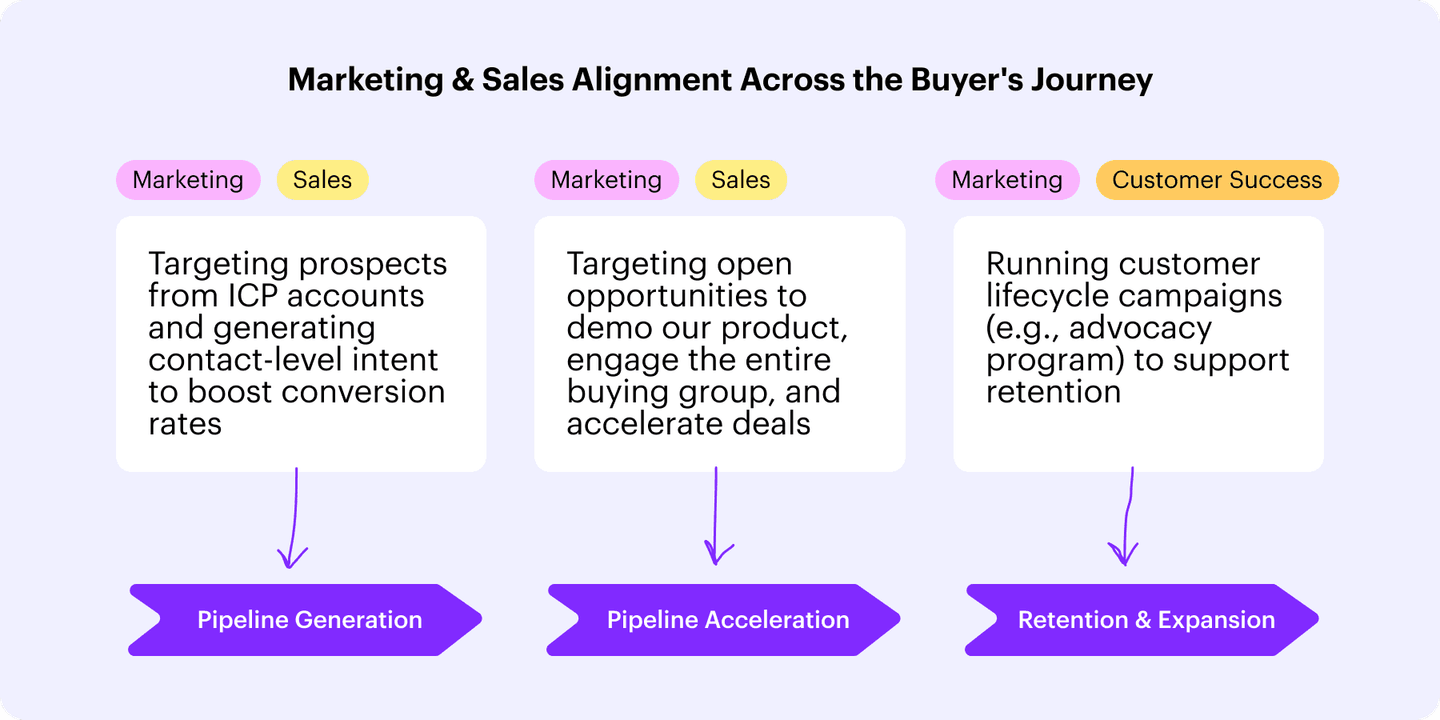
This guide is primarily made for the context of contact-level advertising, but most of the plays we cover are also applicable to other GTM strategies like traditional ABM.
If you’re interested in learning more about contact-level advertising, check out this guide: Contact-Level vs Account-Based Advertising
Now, let’s dive into how to bring your sales and marketing teams together.
The root cause of sales and marketing misalignment
When teams face alignment issues, most people are aware a problem exists, but they’re not sure why or where it stems from. Unless you can identify the root cause, any action you take to address it is a short-term fix.
It's like treating the symptoms of a cold with cough drops when you really need to cure the underlying virus. You might get temporary relief, but the problem will keep coming back until you tackle the real issue.
We’ve found that in a majority of cases, the root cause of sales and marketing misalignment is that both teams have different goals and KPIs.
When sales and marketing aren’t working toward the same outcome, everything else starts to break down. It leads to miscommunication, inefficiencies, and frustration on both sides.
This misalignment doesn’t always look the same, but it tends to show up in four common symptoms:
- Sales and marketing target different audiences.
- Prospects fall through the cracks due to slow or broken handoffs.
- Data and tech stacks are disconnected and unorganized.
- Everyone’s speaking a different language.
Each of these issues creates additional challenges that make collaboration even harder.
So, how do you fix it?
First, we’ll show you how to align sales and marketing around shared goals to address the root cause. Then, we’ll walk through practical strategies to tackle each of the four symptoms so that sales and marketing can start moving in the same direction instead of rowing in circles.
Sales and marketing have conflicting goals
"I did my job."
These are four of the worst words you can say when you're part of a team, and it can be a red flag that sales and marketing aren't aligned.
Usually, when one team says they did their job, it's because the company as a whole isn't doing great, but that team reached their individual goals, so they don't feel responsible.
This issue often pops up when sales and marketing have separate goals and use swim lane metrics to measure success.
For instance, marketing wants to grow top-of-funnel awareness, so their goals are to increase website traffic and MQLs. Sales is trying to improve efficiency, so their goals are to decrease sales cycle length and increase their close rate.
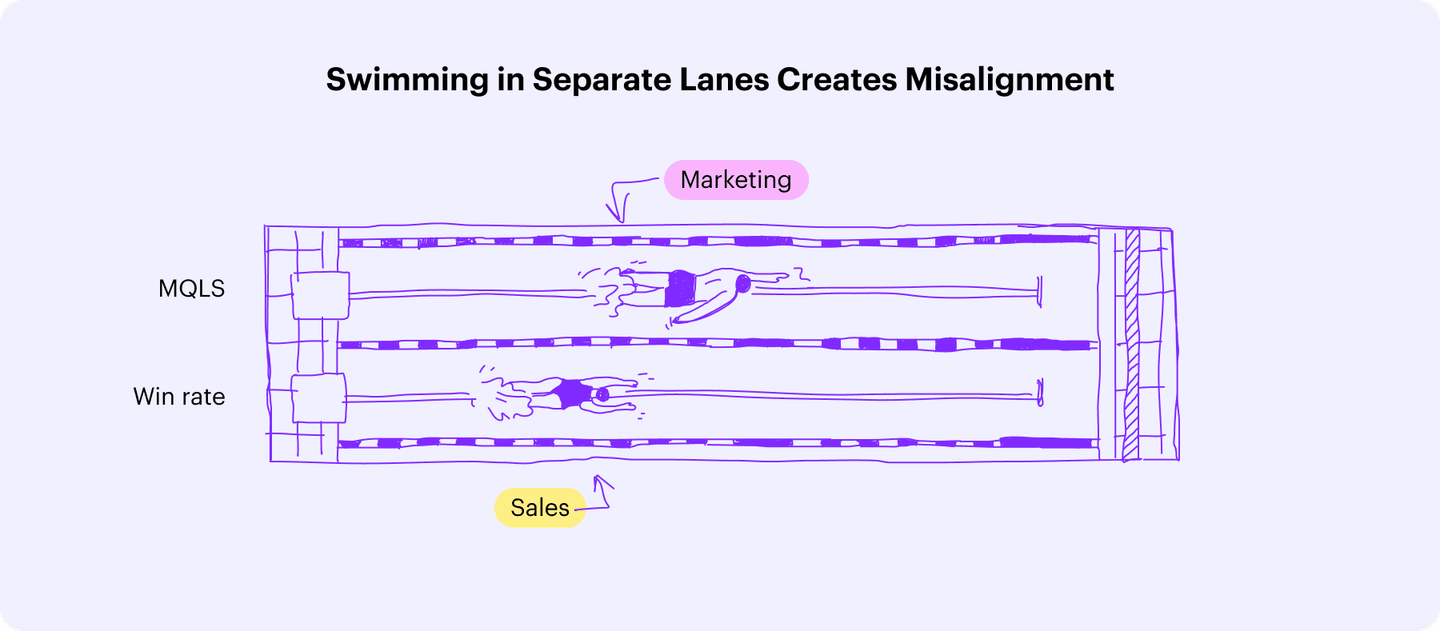
While those metrics might be helpful for those individual teams, they're not aligned to each other or the overall business.
Both teams could overperform on all those goals without the business experiencing any sustainable growth.
The solution: Create shared revenue goals and KPIs
A common trait we found in well-aligned teams is that they treat sales and marketing as a single commercial team and align on a shared revenue goal.
They don't obsess over the number of leads marketing brings in compared to sales-sourced leads.
Instead, they focus on pipeline and revenue because they're metrics both teams can influence and that directly impact business growth.
You can dive even deeper than just tracking how much pipeline and revenue was generated, though. For instance, by syncing with your CRM, Influ2 gives you direct insights into how marketing ads influence pipeline and revenue.
Specifically, you can see how ads influenced:
- Number of meetings booked
- Amount of pipeline generated
- Amount of pipeline progressed
- Amount of revenue won
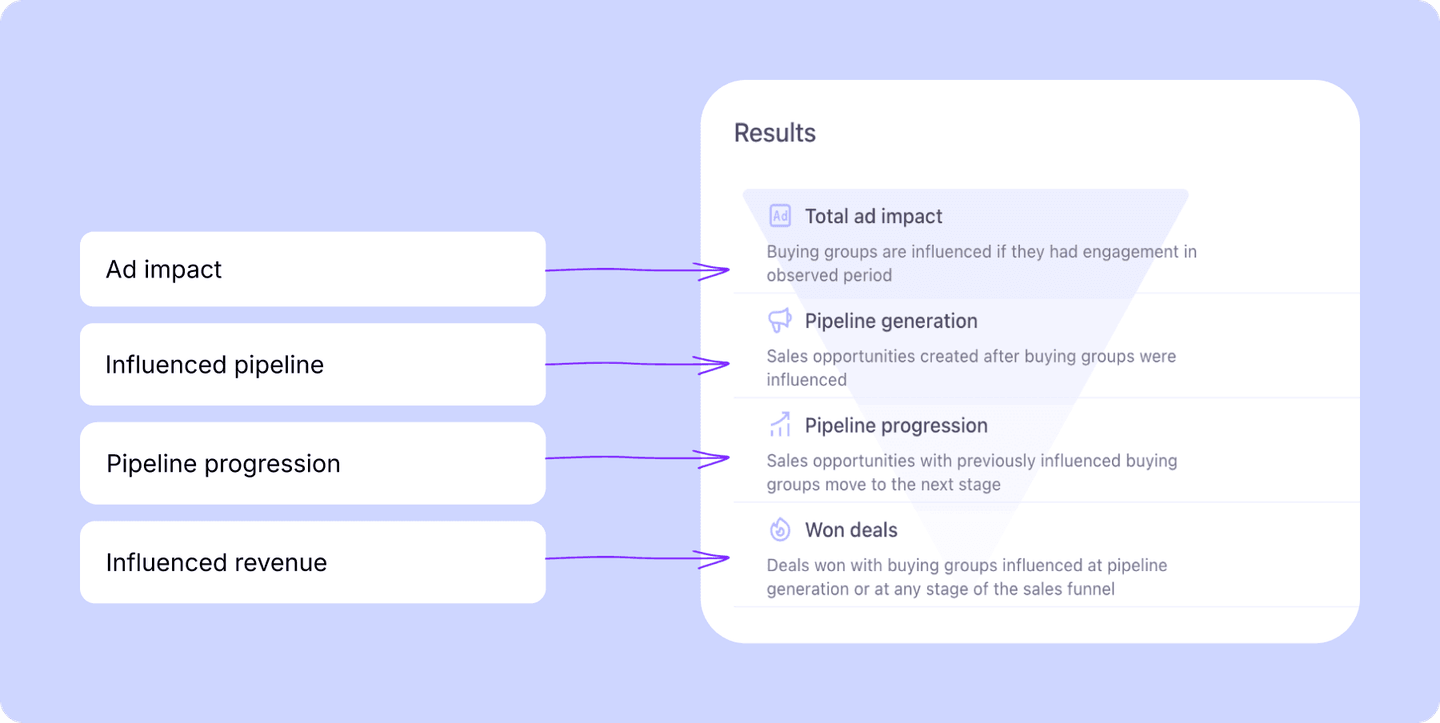
With this data, marketing can quantify the impact of their efforts beyond the number of leads they generated, and sales can see how ads provide additional support to push deals forward at each stage of the sales cycle.
This doesn’t mean that sales and marketing shouldn’t track team-specific metrics.
For instance, marketing can track ad performance data, how many accounts they’re engaging, etc. And sales will still track win rates, sales cycles, and other metrics. However, those metrics should be in support of the overarching goal of pipeline and revenue.
We spoke with Warren Kucker, VP of Sales and Marketing at Tab32, to understand how they measure success.
Since they use Influ2, marketing targets the same contacts and accounts sales is going after. They don’t rely on form-fills to collect leads because they know the people seeing and engaging with their ads are within their ICP, and Influ2 shows who engaged with each ad.

So, rather than gauging marketing’s success by return on ad spend or MQLs generated, they focus on achieving a specific win rate for their target accounts. As long as their win rates are within their threshold and marketing spend isn’t inefficient, they know the ads are working.
Remember, people will optimize what they're measured against. If marketing's success is tied to pipeline and revenue, their strategies and programs will reflect that. The same goes for sales.
And when each team knows that the other can help them impact those goals, it gives them a natural incentive to work together.
Learn more:
Sales and marketing are chasing different audiences
Imagine trying to set a friend up on a blind date. Instead of asking them what they're looking for in a partner, you assume that they want the same thing you want.
You match them up with someone, but when they meet, your friend realizes they're completely incompatible.
A couple of things are going to happen.
First, your friend is going to question why you set them up with someone who's clearly not a good fit.
Then, they'll be less likely to go out with anyone you recommend again, while quietly judging your taste from now on.
That's exactly what happens when marketing and sales don't align on the same audience.
Marketing passes a bunch of MQLs to sales.
Sales reaches out, only to realize that marketing doesn't know who they actually want to talk to.
After that happens enough times, sales starts to ignore MQLs altogether and sticks with cold outreach.
The bigger problem is that some of those MQLs that sales ignores are a good match, but since marketing has sent one too many questionable leads their way, SDRs and AEs get skeptical.
The issue flows the other way as well. Marketing might be launching campaigns, but the sales team has little visibility into who they're targeting.
This results in sales contacting people that marketing hasn't targeted, and marketing targeting people sales isn't contacting.
Both teams have good intentions. Marketing is trying to send leads to sales, but salespeople want to spend their limited bandwidth on people most likely to convert.
But since the teams never came together to define what a good lead looks like, they'll continuously struggle to find a match.
The solution: Build a unified ICP and target audience
First, collaborate on an ideal customer profile (ICP) and target account list.
Sales and marketing should work together to define an ICP that reflects your current happy customers.
Your happy customers are the ones with a high lifetime value (LTV) and retention rates.
Group your happy customers by shared criteria, including:
- Company size
- Industry
- Geographics
- Any other relevant criteria for your business
Then, document your ICP somewhere everyone can access it, like a shared deck or internal wiki.
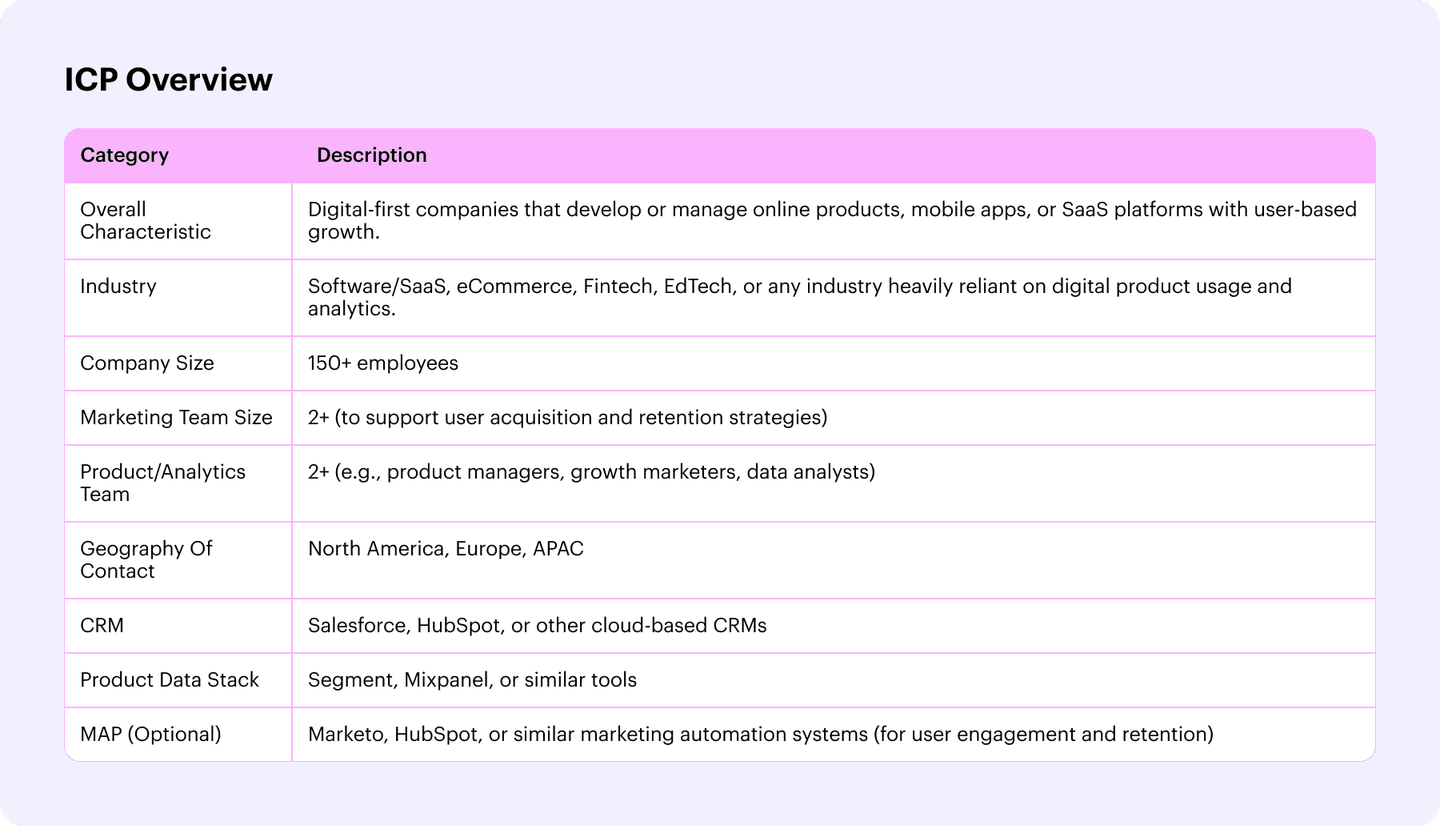
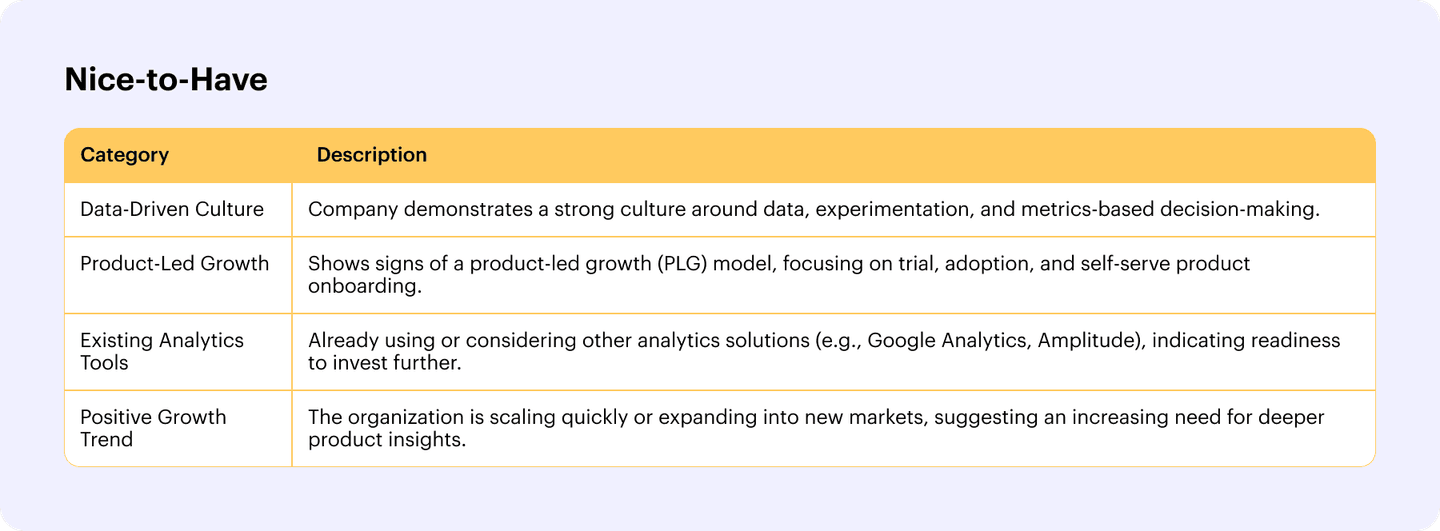
Based on this ICP, build your target account list. Those are the accounts that marketing and sales will target together.
Next, map key contacts within target accounts.
Look at the types of people typically involved in the decision-making process for previous deals you've won.
What titles and levels of seniority are the most common? You can even color-code them by priority so both teams know which titles are the most important.
Document those in a place that's accessible to sales and marketing.
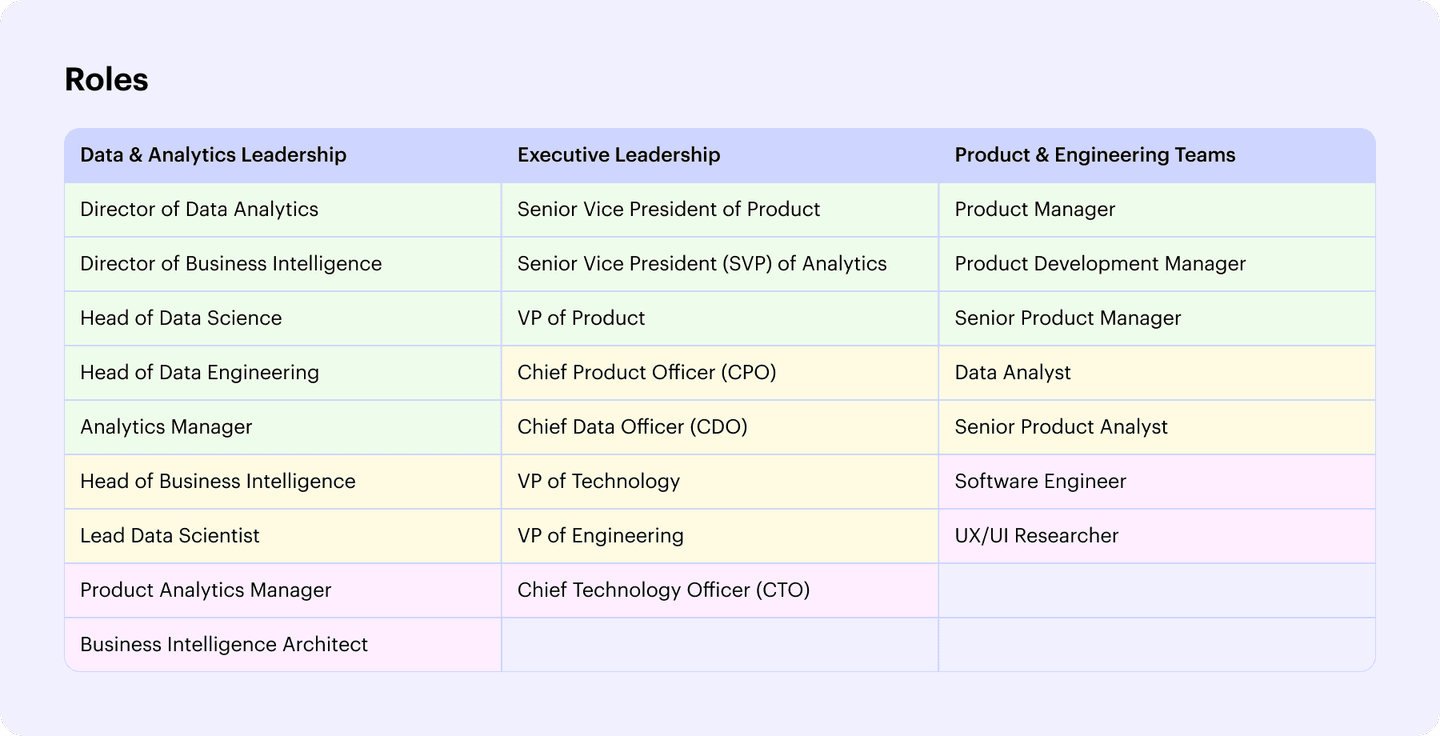
This document will:
- Help marketing build audiences for their ad campaigns (pro tip: Use Influ2 to pull audiences directly from your CRM for ad campaigns)
- Help salespeople know how to prioritize prospects that show intent
Leads are falling through the cracks due to slow or broken handoffs
In our context, a handoff is when a contact from a target account engages with an ad and is prioritized for the sales team to reach out.
In other words, when marketing tells sales, “Hey, this person is showing some interest. Now would be a good time to contact them.”
There are two main issues that can happen with handoffs:
- Sales doesn't follow up with prioritized prospects at all.
- Sales waits too long to follow up with prioritized prospects.
Let's start with the first scenario.
In our State of Sales & Marketing Alignment Report, we found that 53% of companies experience a broken handoff where sales follows up with less than 35% of marketing-engaged prospects.
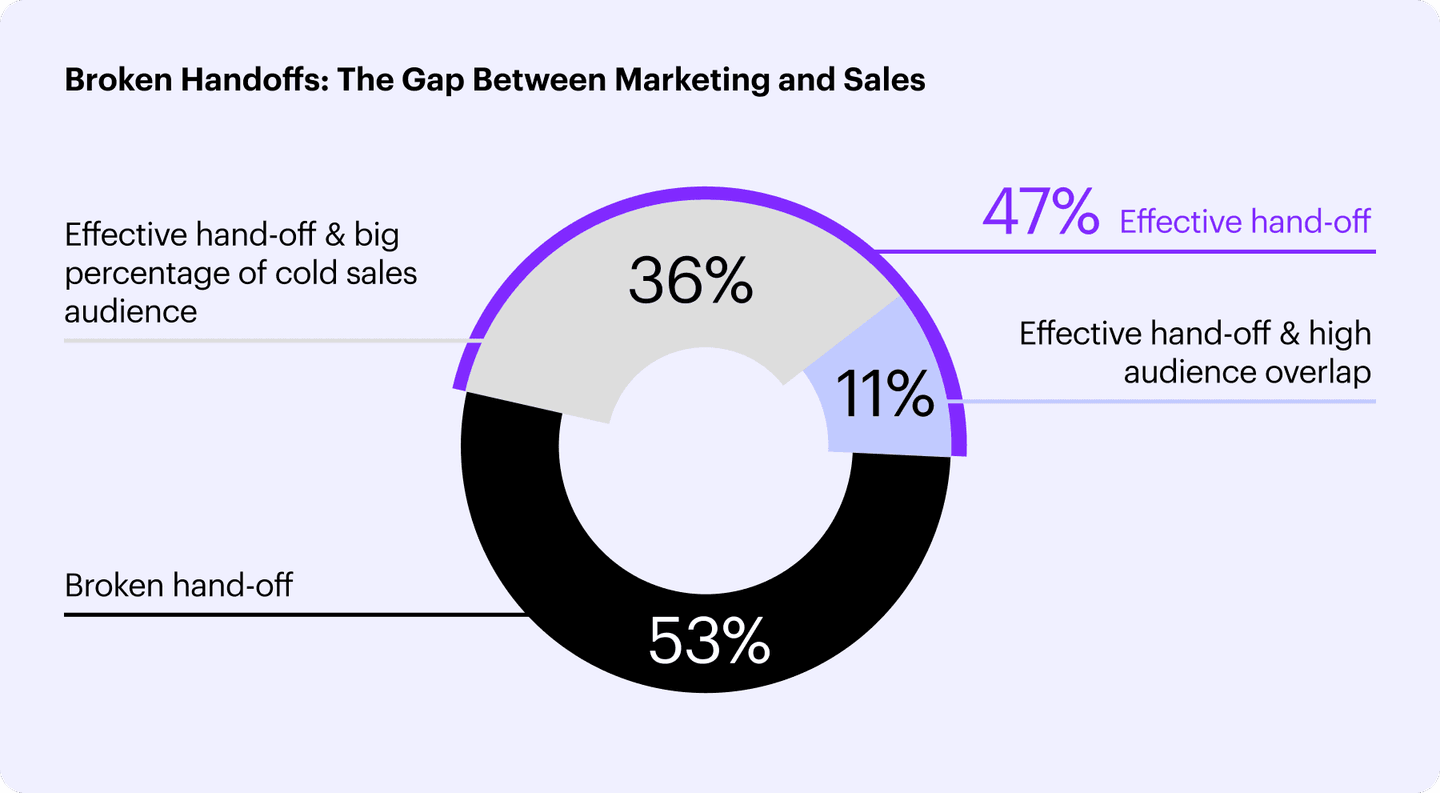
In other words, less than half of prospects who engage with marketing’s ads receive sales outreach.
On the surface, that's an alarming statistic, but when we dug further into it, we found it's often a result of the company's GTM strategy.
For instance, marketing may be focused on building awareness, while sales goes after a list of “whale” accounts. In that scenario, sales is likely prioritizing their target accounts over the broadly targeted audience that marketing is engaging.
The second scenario is more troubling.
It’s when your sales team is reaching out to engaged prospects, but it takes them a while to get to it.
The period between the ad engagement and when a salesperson contacts the prospect is critical. According to a Nielsen study, people’s ability to recall an ad they saw drops by 50% within 24 hours.
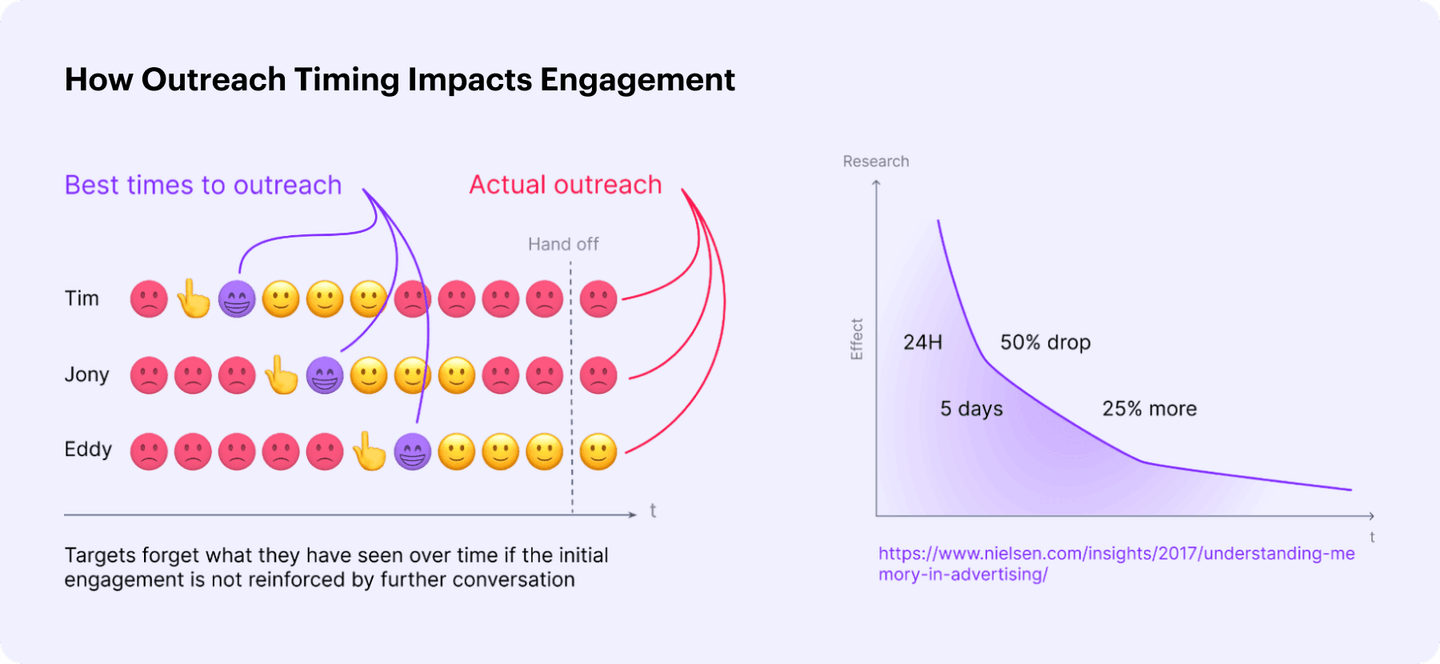
So just like a hot meal fresh from the oven, the longer you wait to serve it, the colder it gets.
By the time sales finally makes contact, the prospect’s interest has cooled, their attention has shifted, and the impact of your marketing efforts has faded.
Instead of engaging in a relevant conversation, your rep is now starting from scratch—reintroducing your brand, rebuilding curiosity, and fighting against distractions that could've been avoided with faster follow-up.
The solution: Set guidelines for how to handle intent signals
One way to prevent broken handoffs is for marketing and sales to align on how to handle intent signals. You need alignment on:
- What’s considered actionable intent
- When to respond to an intent signal
- How to use intent signals for outreach
Actionable intent is the threshold for when a handoff happens.
Since our strategy is built on contact-level advertising, we use ad engagement as our main intent signal. For us, actionable intent means a prospect has clicked an ad at least once.
When that threshold is reached, the prospect is marked as a priority in Influ2, and the sales team gets notified. This all happens automatically with our Influ2 > CRM integration.
Your threshold might look different. For instance, you could require multiple ad clicks or an ad click plus an additional intent signal. The most important thing is that both marketing and sales agree on what an actionable intent signal is to prevent broken handoffs.
We spoke to one customer who has automated the hand-off process to ensure follow-ups happen immediately. Here’s how their process works:
Step 1 : Identify and warm up target accounts
- Sales and marketing create a list of roughly 500 target accounts that match their ICP.
- Marketing uses awareness ads to engage specific buying committees within each target account.
- Marketing tracks when contacts from those accounts engage with their ads (via Influ2).
Step 2: Qualify leads based on engagement
- Prospects are scored based on activity thresholds, including ad engagement and other intent signals.
- Prospects are surfaced to sales once they've met the threshold.
Step 3: Assign leads to the right salesperson
- Once a prospect is considered qualified, they're automatically assigned to a salesperson in Hubspot based on criteria like region or account size.
- The salesperson is assigned a series of tasks for prospects (more on this in step five).
Step 4: Personalized outreach
- Prospects are placed into one of 16 sales sequences based on persona (role or seniority), the type of content they engaged with, or pain points inferred from their engagement.
Step 5: Sales follow-ups and ongoing nurturing
- If a prospect doesn't respond to the initial email, the sequence continues until they reply or they're deemed not ready, and sales pauses their outreach.
- Using Hubspot's dynamic sequences, when a prospect responds to one of the automated emails, a new task is created for the salesperson to send a manual reply.
Crawl, walk, then run:
- Their initial program started with 80 accounts. Eventually, they grew to 250 and then 500. That gave them the ability to hone their processes and systems to see what worked and then start scaling.
The last piece of the puzzle is aligning on how to use intent signals in your outreach.
To maintain consistent messaging, sales can use intent data to personalize their calls, emails, and LinkedIn messages based on what the prospect showed interest in.
For example, salespeople can use the messaging from the ad a prospect clicked in the subject line and body of their emails.

This approach makes your outreach more relevant than a cold call or email where you need to make (often inaccurate) assumptions about what the prospect is interested in.
Learn more:
Messy data and disconnected tech are causing chaos
Think of your company’s sales and marketing data like a hallway closet.
At first, it starts with just a few misplaced things—a couple of duplicate contacts here, some outdated account records there.
It’s annoying, but manageable. So, instead of cleaning it up, you shove it to the back and promise to “deal with it later.”
But over time, the closet gets more cluttered.

Every new marketing automation, web personalization, and sales engagement tool you add is like throwing more random stuff into the pile.
Instead of a clean, organized system, you have a disorganized mess where no one can find the data they need.
Contacts have changed jobs, phone numbers and emails are outdated, and you have a bunch of unused and redundant fields in your CRM.
This is the reality a lot of teams are experiencing, and it causes confusion and frustration for sales and marketing.
The solution: Regularly clean up and centralize your data
There’s no easy way around this one. You need to Marie Kondo your data—specifically your CRM.
Your CRM is where marketing and sales data flows to and from. If it’s inaccurate, marketing’s campaigns might not reach the right people and sales outreach will be based on incorrect or incomplete information.
It’s a recipe for disaster, and according to a survey from Validity, 44% of companies have lost over 10% in annual revenue due to poor-quality CRM data.

Fixing it is a two-step process. First, clean up what’s currently there to start fresh. Then maintain it moving forward.
The initial cleanup phase is beyond the scope of this guide, but Improvado recommends a five-step process for cleaning up your data that’s applicable to pretty much any data source:
- Validate your data
- Align data formats
- Get rid of duplicates
- Normalize missing and incomplete data
- Identify conflicts in your database
Part of your cleanup process should involve ensuring all your data is syncing correctly. Whether you’re using data enrichment tools, sales engagement platforms, or even Influ2, make sure the data is syncing and updating properly with your CRM.
Just like your house, keeping your data clean requires maintenance. Check to make sure your data is accurate and connecting properly at least once or twice a month.
Everyone’s speaking a different language
A lot of times, we assume everyone in a company defines things the same way.
However, that's not always the case, particularly in larger companies where each team has its own acronyms and definitions.
Here's a quick way to test where your company stands.
Ask your AE's, "What's considered a qualified lead?"
Then, ask marketing, CRO, SDRs, and operations the same question.
You can do this with any key terms or metrics your company uses.
If you get different responses from everyone, that's a sign of misalignment.
The solution: Document key terms and processes
Create a document that includes clear definitions of the KPIs and metrics both teams track, as well as your standard operating procedures (SOPs).
Your documentation should outline important details like:
- What to do with each type of intent signal
- The handoff process after intent signals come through
- Definitions of key terms (lead statuses, stages, etc.)
- Explanations of your CRM fields, and how they're supposed to be used
- How to handle common scenarios that people have questions about
It’s not the most exciting part of building alignment, but it’ll help prevent situations where people don't know what to do, so they do nothing or the wrong thing.
Pro tip: Have a catalyst for change
Aligning sales and marketing is a team effort, but one thing we've found is there's usually someone that kicks off the process.
In some cases, it's a new hire who has dealt with misalignment before, recognizes the signs, and wants to shift the culture.
Newcomers are good catalysts because they disrupt the status quo.
What tends to happen in companies is that after a while, misalignment becomes the norm, and people just accept it. It’s a little psychological phenomenon known as the normalization of deviance.
That is, until someone new comes along and says, "This isn't normal. Let’s change it."
We're not suggesting you go out and hire a new role to fix your alignment issues. Large-scale changes like this, however, need a champion to drive the effort.
Otherwise, people are prone to continue with how they've always done things, even if they know it's a problem.
Note: If you're interested in being a catalyst to bring marketing and sales together in your company, we'd love to show you how contact-level ads can help!
How to measure sales and marketing alignment
If I were to ask you "how well aligned are sales and marketing in your company," what would you say?
It'd probably be a qualitative response based on your gut feeling like "they work well together" or "it's a mess."
Those responses are interesting, but not actionable.
We wanted to give teams the ability to answer that question with a quantitative response based on data. Plus, once you start implementing some of the changes in this guide, you’ll need a way to measure your progress.
So, we created a Sales and Marketing Alignment Dashboard for Influ2.
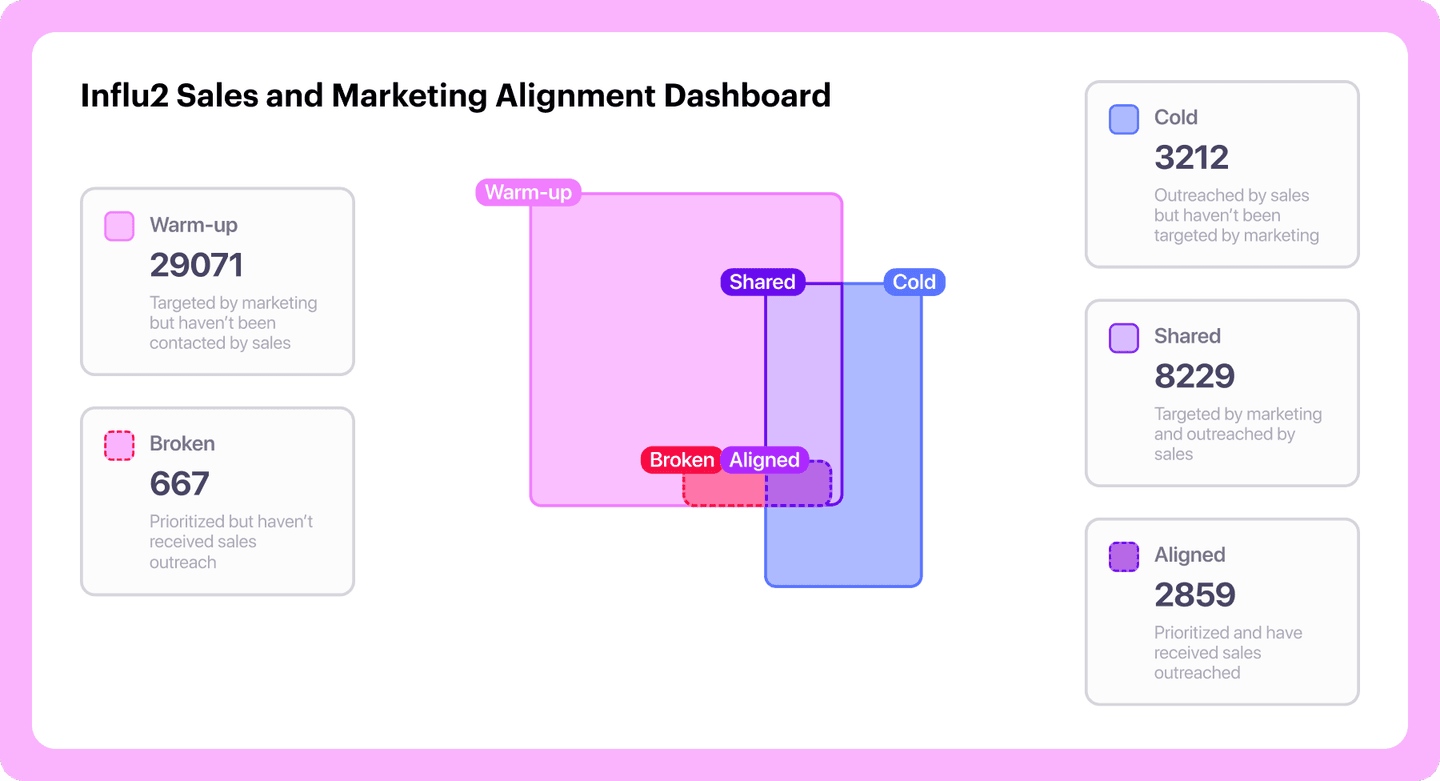
The dashboard measures five key alignment metrics:
- Warm-up audience: The number of contacts who were targeted by marketing, but not outreached by sales.
- Broken hand-offs: The number of contacts who were prioritized for sales outreach, but not outreached.
- Cold outreach audience: The number of contacts who were outreached by sales, but not targeted by marketing.
- Shared audience: The number of contacts who were targeted by marketing and outreached by sales.
- Aligned hand-offs: The number of contacts who were prioritized for sales outreach and outreached.
We also give you insights into how sales and marketing alignment are affecting your program's success.
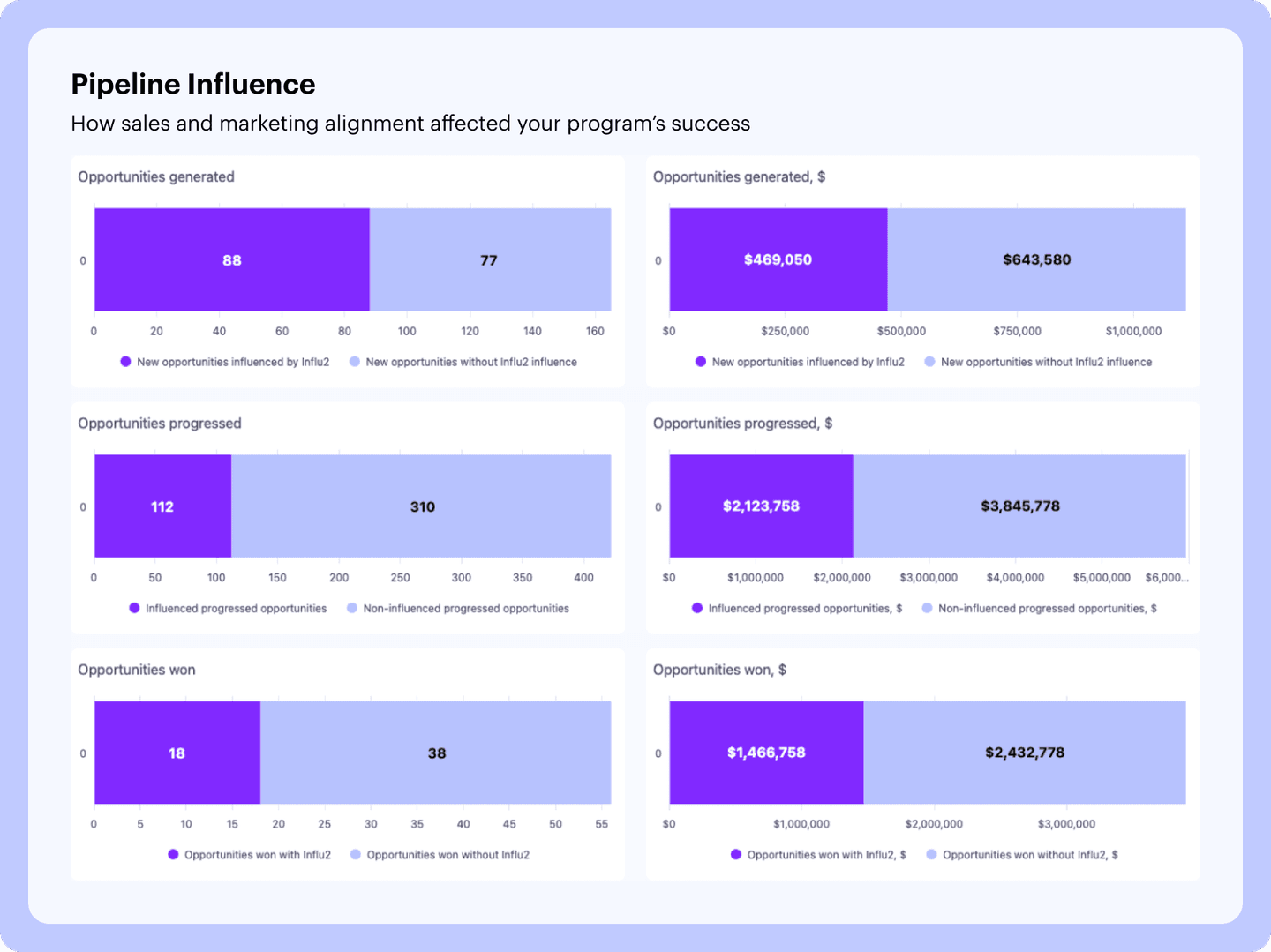
Having this data available is nice, but turning it into action is where you’ll get the real value. Here are some tangible ways you can improve sales and marketing alignment with this dashboard:
Improve the hand-off process
A low percentage of successful handoffs is a sign that marketing is prioritizing engaged prospects for sales, but they aren't being followed up on (i.e. broken handoffs).
Dive deeper into why that's happening and, if necessary, put together a plan to fix it. It could involve automating the first sales touch or establishing service level agreements (SLAs) between sales and marketing for the handoff process.
Increase marketing's target audience
Warmed up audiences convert to pipeline at a higher rate than cold ones.
If you have a large cold audience, it's a sign that marketing has an opportunity to target a wider audience to give sales additional support.
The dashboard shows you what percentage of sales-outreached people were targeted by marketing, so you have a KPI to track your performance against.
Spot potential audience misalignment
If your warmed up audience and cold outreach audience are both high, it could indicate that:
- Marketing is showing ads to people sales isn't contacting
- Sales is contacting people marketing isn't targeting
In other words, there's audience misalignment.
Assuming there isn't a valid reason for this (e.g. sales is focused on specific high-priority segments while marketing is primarily focused on broad awareness), this is a significant opportunity to better align the teams.
In this scenario, your goal could be to increase the shared audience size so that marketing and sales can simultaneously target more of the same people.
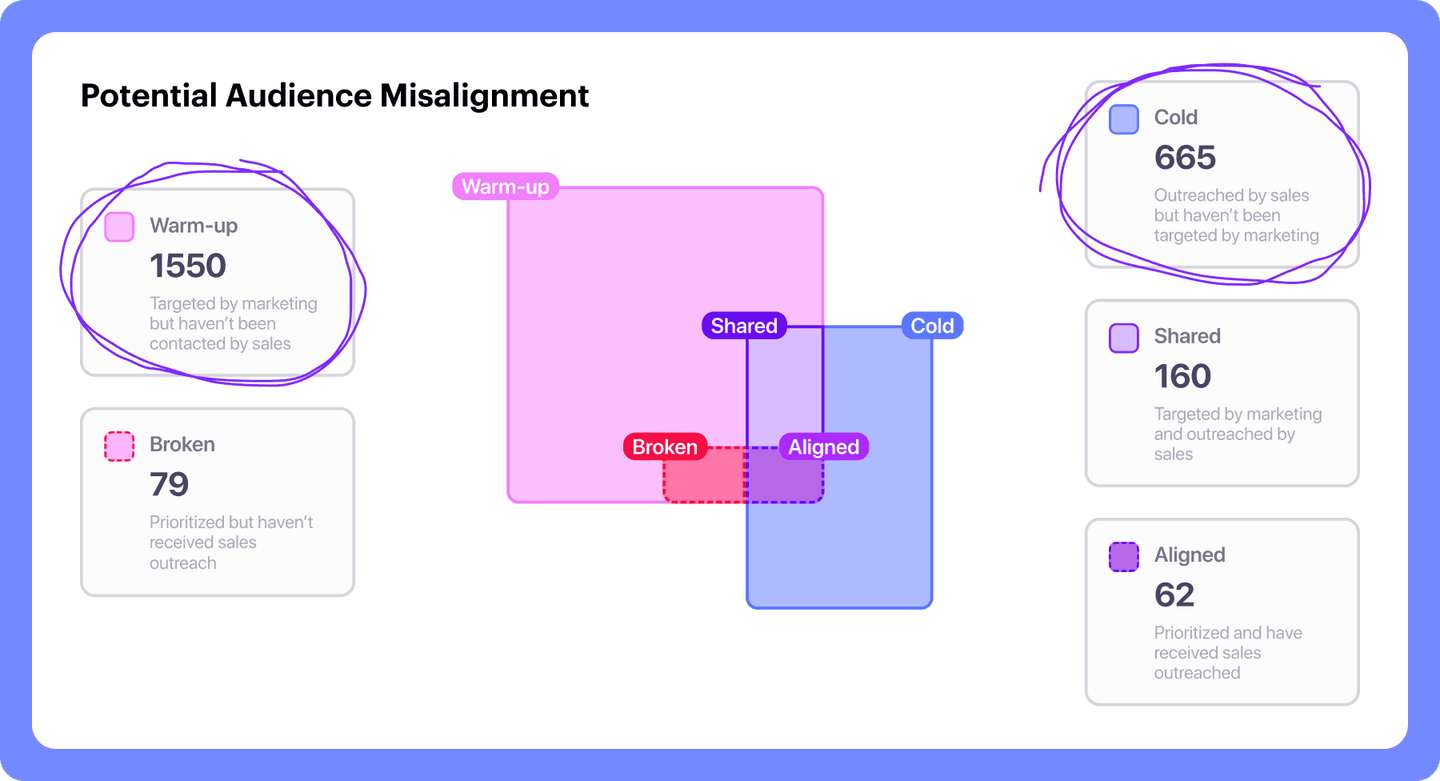
This is just the tip of the iceberg in terms of the insights you can get from the Sales & Marketing Alignment Dashboard.
If you're interested in a deeper dive, check out this video.
Final thoughts
By now, you have a clear picture of why sales and marketing alignment breaks down—and a blueprint for fixing it.
But knowing isn’t enough.
The best teams don’t just talk about alignment; they put systems in place to make it happen.
Our Sales & Marketing Alignment Dashboard is a great place to start so you can get benchmarks on where your team sits today.
And if you want a partner to help sales and marketing win together, let’s talk about how contact-level ABM can make it easier.


